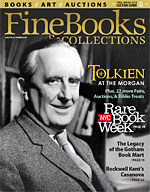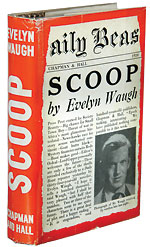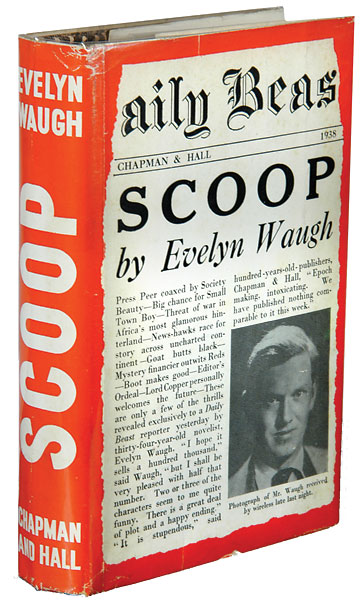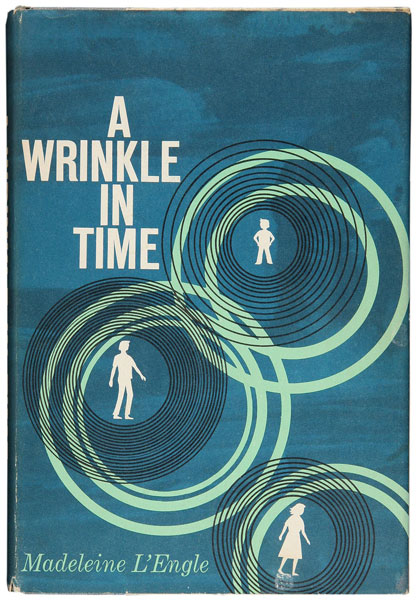Flush This Book
18th Century Commode, Bloomsbury New York, $1800
Using the form of a book to disguise an entirely different function, or to hide something away, is nothing new—think of money boxes, for example. But book as bathroom?
It does not seem an obvious use for an old binding, but this traveling commode might have appealed to Apthorpe, the obsessive officer in Evelyn Waugh’s novel, Men at Arms. Apthorpe, some readers may recall, owned an Edwardian field latrine, a so-called “thunderbox” that came to a comic and explosive end. The example seen in New York, by contrast, survived relatively unscathed since the 18th century. It sold for $1,800 in a Bloomsbury New York auction, September 17-18, 2008.
Two of its supporting walls are the blind-tooled calf-over-oak-board covers of a large folio volume that advertises itself on the red morocco label to be an Historia Universalis. Closed, it looks just like any other large old folio, but in times of need oaken boards fold out to form a closed square, or lift up to provide a seat in which a chamber pot could be placed. The whole thunderbox, perhaps intended for use on a military campaign by someone of rank, rests on four small wooden pegs and the sides formed by the binding are further protected at the foot by small brass plates. The wooden seat is cracked, the chamber pot itself long gone, and the binding seen some restoration, but have you ever seen another thunderbox of this age and grandeur, let alone one with such literary reverberations?
Great Scoop
Waugh’s Comic Novel in Original Jacket, Bloomsbury London, £3,600
Speaking of Evelyn Waugh, when Scoop, Waugh’s brilliant comic satire on the world of British journalism, was first published in 1938, its dust jacket featured a mock-up of The Daily Beast, the newspaper that mistakenly sends a mild-mannered “Nature Notes” contributor, William Boot, to cover a war in Ishmaelia, instead of novelist John Boot. The domineering proprietor of Waugh’s newspaper was called Lord Copper, but the typeface used in the masthead on the dust jacket closely resembled that favored by Lord Beaverbook’s real life Daily Express, and he threatened to sue if this obvious visual play was not removed. A copy retaining that original dust jacket was sold for a record £3,600 ($6,110) by Bloomsbury Auctions of London on October 17, 2008.
Lucky L’Engle
1962 Edition, A Wrinkle in Time, PBA San Francisco, $10,800
Thirty publishers turned down Madeleine L’Engle’s first story about the Murry and O’Keefe families, A Wrinkle in Time. Her science fiction fantasy for children, they said, was just “too different.”
Then in 1962, Ariel Books/Farrar, Strauss & Cudahy took a chance with a book that within a twelvemonth had won the American Library Association’s prestigious John Newbery Medal as the outstanding American children’s book of the year—the first in a series of awards.* As with the first Harry Potter book, the initial print run was small, and records suggest it’s been nearly 20 years since a copy of the 1962 first edition was seen at auction—a copy that sold for $120 at California Book Auctions of San Francisco.
That particular wrinkle in time smoothed out on August 21, 2008, when the firm that later morphed into PBA Galleries of San Francisco saw a first edition bid to $10,800.
*Readers may wish to know that the 2008 winner of the Newbery Medal was Laura Amy Schmitz with Good Masters! Sweet Ladies! Voices from a Medieval Village.








 Ian McKay’s weekly column in Antiques Trade Gazette has been running for more than 30 years.
Ian McKay’s weekly column in Antiques Trade Gazette has been running for more than 30 years.





